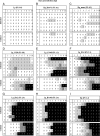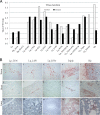A Unique Multibasic Proteolytic Cleavage Site and Three Mutations in the HA2 Domain Confer High Virulence of H7N1 Avian Influenza Virus in Chickens
- PMID: 26491158
- PMCID: PMC4702528
- DOI: 10.1128/JVI.02082-15
A Unique Multibasic Proteolytic Cleavage Site and Three Mutations in the HA2 Domain Confer High Virulence of H7N1 Avian Influenza Virus in Chickens
Abstract
In 1999, after circulation for a few months in poultry in Italy, low-pathogenic (LP) avian influenza (AI) H7N1 virus mutated into a highly pathogenic (HP) form by acquisition of a unique multibasic cleavage site (mCS), PEIPKGSRVRR*GLF (asterisk indicates the cleavage site), in the hemagglutinin (HA) and additional alterations with hitherto unknown biological function. To elucidate these virulence-determining alterations, recombinant H7N1 viruses carrying specific mutations in the HA of LPAI A/chicken/Italy/473/1999 virus (Lp) and HPAI A/chicken/Italy/445/1999 virus (Hp) were generated. Hp with a monobasic CS or carrying the HA of Lp induced only mild or no disease in chickens, thus resembling Lp. Conversely, Lp with the HA of Hp was as virulent and transmissible as Hp. While Lp with a multibasic cleavage site (Lp_CS445) was less virulent than Hp, full virulence was exhibited when HA2 was replaced by that of Hp. In HA2, three amino acid differences consistently detected between LP and HP H7N1 viruses were successively introduced into Lp_CS445. Q450L in the HA2 stem domain increased virulence and transmission but was detrimental to replication in cell culture, probably due to low-pH activation of HA. A436T and/or K536R restored viral replication in vitro and in vivo. Viruses possessing A436T and K536R were observed early in the HPAI outbreak but were later superseded by viruses carrying all three mutations. Together, besides the mCS, stepwise mutations in HA2 increased the fitness of the Italian H7N1 virus in vivo. The shift toward higher virulence in the field was most likely gradual with rapid optimization.
Importance: In 1999, after 9 months of circulation of low-pathogenic (LP) avian influenza virus (AIV), a devastating highly pathogenic (HP) H7N1 AIV emerged in poultry, marking the largest epidemic of AIV reported in a Western country. The HPAIV possessed a unique multibasic cleavage site (mCS) complying with the minimum motif for HPAIV. The main finding in this report is the identification of three mutations in the HA2 domain that are required for replication and stability, as well as for virulence, transmission, and tropism of H7N1 in chickens. In addition to the mCS, Q450L was required for full virulence and transmissibility of the virus. Nonetheless, it was detrimental to virus replication and required A436T and/or K536R to restore replication, systemic spread, and stability. These results are important for better understanding of the evolution of highly pathogenic avian influenza viruses from low-pathogenic precursors.
Copyright © 2015, American Society for Microbiology. All Rights Reserved.
Figures





References
-
- Tong S, Zhu X, Li Y, Shi M, Zhang J, Bourgeois M, Yang H, Chen X, Recuenco S, Gomez J, Chen LM, Johnson A, Tao Y, Dreyfus C, Yu W, McBride R, Carney PJ, Gilbert AT, Chang J, Guo Z, Davis CT, Paulson JC, Stevens J, Rupprecht CE, Holmes EC, Wilson IA, Donis RO. 2013. New World bats harbor diverse influenza A viruses. PLoS Pathog 9:e1003657. doi:10.1371/journal.ppat.1003657. - DOI - PMC - PubMed
MeSH terms
Substances
LinkOut - more resources
Full Text Sources
Medical
Research Materials
Miscellaneous

